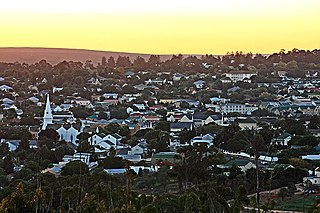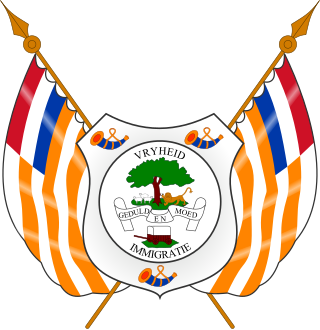
The lines of partition used to divide and vary fields and charges in heraldry are by default straight, but may have many different shapes. Care must sometimes be taken to distinguish these types of lines from the extremely unusual and non-traditional use of lines as charges, and to distinguish these shapes from actual charges, such as "a mount [or triple mount] in base," or, particularly in German heraldry, different kinds of embattled from castle walls.

Bellville is a town in the Western Cape province of South Africa. It is situated adjacent to the Koelberg Mountains and also the University of Western Cape where it has its own campus.

Krugersdorp is a mining city in the West Rand, Gauteng Province, South Africa founded in 1887 by Marthinus Pretorius. Following the discovery of gold on the Witwatersrand, a need arose for a major town in the west of the reef. The government bought part of the Paardekraal farm and named the new town after the Transvaal president, Paul Kruger. Krugersdorp no longer has a separate municipal government after it was integrated into Mogale City Local Municipality along with surrounding towns. It is now the seat of government for Mogale City.

The lozenge in heraldry is a diamond-shaped rhombus charge, usually somewhat narrower than it is tall. It is to be distinguished in modern heraldry from the fusil, which is like the lozenge but narrower, though the distinction has not always been as fine and is not always observed even today. A mascle is a voided lozenge—that is, a lozenge with a lozenge-shaped hole in the middle—and the rarer rustre is a lozenge containing a circular hole in the centre. A field covered in a pattern of lozenges is described as lozengy; similar fields of mascles are masculy, and fusils, fusily. In civic heraldry, a lozenge sable is often used in coal-mining communities to represent a lump of coal.

Simon's Town, sometimes spelled Simonstown, is a town in the Western Cape, South Africa and is home to Naval Base Simon's Town, the South African Navy's largest base. It is located on the shores of False Bay, on the eastern side of the Cape Peninsula. For more than two centuries it has been a naval base and harbour. The town is named after Simon van der Stel, an early governor of the Cape Colony.

Steve Biko Academic Hospital of Pretoria, South Africa, previously located at what is now Tshwane District Hospital, is a purely tertiary training healthcare institution. It is the main teaching hospital of the University of Pretoria along with Kalafong Hospital in Atteridgeville to west of the city centre.
The International Association of Amateur Heralds (IAAH) is a group of heraldic enthusiasts from around the world that exists to discuss all aspects of heraldry. It was formerly known only as the Association of Amateur Heralds, or AAH. The Association exists only in cyberspace and was created to encourage the art and science of heraldry through helping people with heraldic enquiries. The Association's stated aim is promotion and education in the fields of the art and science of heraldry. This vision was the core driving principle of the Association's foundation. Although people and positions change, the Association continues to grow and evolve. The founding principles remain intact, as a result of contributions by volunteers from among its membership acting in various capacities. Members contribute articles on the subject of heraldry, refine the Association's articles and bylaws, and service arms design requests by members of the public. Members continue to contribute towards the roll of arms which reflects the work of the Association's heralds and heraldic artists.

The coat of arms of Namibia is the official heraldic symbol of Namibia. Introduced at the time of independence in 1990, it superseded the earlier coat of arms used by the South African administration of the territory.

The coat of arms of Cape Town is the traditional symbol of the municipality of Cape Town. The original arms from the 20th century are no longer in official use, though no new arms have yet been adopted.

Malmesbury is a town of approximately 36,000 inhabitants in the Western Cape province of South Africa, about 65 km north of Cape Town.

South African heraldry dates back to the 1650s, inheriting European heraldic traditions. Arms are borne by individuals, official bodies, local authorities, military units, and by a wide variety of organisations. South Africa has had its own heraldic authority since 1963, to provide armigers with legal protection, and to promote high standards of armorial practice.
The Diocese of the Highveld is a diocese of the Anglican Church of Southern Africa covering the East Rand in Gauteng province and the southern part of Mpumalanga province in South Africa. The bishop's seat is at St Dunstan's Cathedral in Benoni.

In heraldry, a pile is a charge usually counted as one of the ordinaries. It consists of a wedge emerging from the upper edge of the shield and converging to a point near the base. If it touches the base, it is blazoned throughout.
Goodwood is a suburb of Cape Town in the Western Cape, South Africa and is situated in the Tygerberg region of the City of Cape Town. It is 10 kilometres from Cape Town and accessible from the N1, N7 and N2 highways.

The coat of arms of the Orange Free State was the official heraldic symbol of the Orange Free State as a republic from 1857 to 1902, and later, from 1937 to 1994, as a province of South Africa. It is now obsolete.

The coat of arms of the Transvaal was the official heraldic symbol of the South African Republic from 1866 to 1877 and again from 1881 to 1902, and later the symbol of the Transvaal Province from 1954 to 1994 in a simplified form. It is now obsolete.

The Somerset Hospital in the Green Point area of Cape Town, South Africa opened in 1864 and has been declared a provincial heritage site.
Livingstone Hospital is a large Provincial government-funded hospital situated in Korsten, Port Elizabeth in South Africa. It is a tertiary hospital and forms part of the Port Elizabeth Hospital Complex.
Tower Psychiatric Hospital is a government-funded psychiatric hospital and psychosocial rehabilitation Centre in the Raymond Mhlaba Local Municipality area of Fort Beaufort, Eastern Cape in South Africa. It provides long-term psychiatric care and psychosocial rehabilitation services to the entire Eastern Cape. The hospital has a full-time psychiatrist since December 2015.

Tygerberg Hospital is a tertiary hospital located in Parow. The hospital was officially opened in 1976 and is the largest hospital in the Western Cape and the second largest hospital in South Africa, with the capacity for 1899 beds. It acts as a teaching hospital in conjunction with the Stellenbosch University's Health Science Faculty. To become a patient at Tygerberg, a person must be referred by a primary or secondary health care facility. Over 3.6 million people receive health care from Tygerberg, either directly or via its secondary hospitals, such as Paarl and Worcester Hospital. During the normal working day there are about 10,000 people on hospital grounds.















